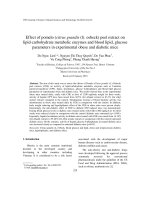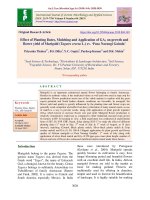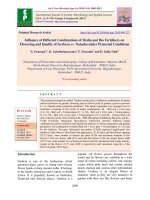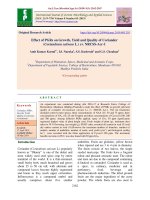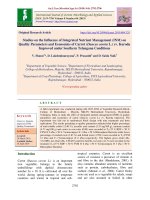Effect of different levels of fertigation on flowering and storage life of marigold (Tagetes erecta L.) CV. Pusa Narangi Gainda
Bạn đang xem bản rút gọn của tài liệu. Xem và tải ngay bản đầy đủ của tài liệu tại đây (187.53 KB, 6 trang )
Int.J.Curr.Microbiol.App.Sci (2018) 7(12): 521-526
International Journal of Current Microbiology and Applied Sciences
ISSN: 2319-7706 Volume 7 Number 12 (2018)
Journal homepage:
Original Research Article
/>
Effect of Different Levels of Fertigation on Flowering and Storage Life of
Marigold (Tagetes erecta L.) CV. Pusa Narangi Gainda
Kurakula Divya*, A. Girwani1, D. Vijaya2 and P. Prasanth3
1
2
College of Horticulture, Mojerla, India
Soil Science, Grape Research Station, Rajendranagar, India
3
Floricultural Research Station, Rajendranagar, India
*Corresponding author
ABSTRACT
Keywords
Marigold,
Fertigation, Water
soluble fertilizers,
Flower parameters,
Shelf life
Article Info
Accepted:
07 November 2018
Available Online:
10 December 2018
An experiment was conducted to study the effect of levels of fertigation on flowering and
shelf life of marigold (Tagetes erecta L.) cv. Pusa Narangi Gainda under open conditions
at Floricultural Research Station, Rajendranagar, Hyderabad during 2016-2017. The
experiment consisted of seven levels of fertigation treatments with combination of water
soluble and straight fertilizers. The results revealed that flowering and storage life of
marigold flowers were significantly influenced by different levels of fertigation. Duration
of flowering (45.74 days), number of pickings per month (5.10), flower yield per plot
(23.37 kg /plot) and flower yield per hectare (14.42 t/ha) were maximum with the
application of 75 per cent of recommended dose of fertilizers (RDF) with Water Soluble
fertilizers. Further at the same fertigation level shelf life of flowers (3.59 days) and shelf
life of flowers packed in polyethylene cover (5.25 days) were recorded maximum.
Introduction
In India, various traditional flowers have been
growing since time immemorial, among those,
marigold has a unique status. Marigold is one
of the easiest grown annual flowers and has
wide adaptability to different soil and climatic
conditions. The plants with their attractive
flower colour and long blooming period
remain fresh for quite a long time after
plucking. All these factors have made
marigold as one of the most popular annual
flowers in India, for garden display as well as
for commercial cultivation.
Fertigation is found to be a most proven
technique for applying nutrients through micro
irrigation systems directly at the site of active
root zone. It has potential for more accurate
and timely crop nutrition leading to increased
yields, enhanced quality and early crop
maturity. Fertigation also helps to reduce the
wastage of nutrients through enhanced
fertilizer use efficiency, besides providing
flexibility in timing of fertilizer application in
relation to crop demand based on
physiological stages of growth (Papadopoulos,
1992), it also helps in economizing the use of
water and fertilizers and reducing the cost of
521
Int.J.Curr.Microbiol.App.Sci (2018) 7(12): 521-526
cultivation by reducing the cost of water,
fertilizers, labour and energy (Khan et al.,
1997). Inadequate plant nutrition causes
serious nutritional disorders in marigold
cultivation and may eventually lead to decline
of plant vigour and ultimately reduction of
yield.
Hence, for successful cultivation of marigold
optimum level of fertilizer dosages through
fertigation need to be worked out in improving
the fertilizer use efficiency and reducing the
cost of cultivation. In view of above facts the
present work has been taken up to study the
influence of different levels of fertigation and
sources of nutrients in marigold cv. Pusa
Narangi gainda.
The drip irrigation system and venturi injector
fertigation unit were installed as per the
experimental layout and treatment plan.
Twenty five days old healthy and uniform
seedlings of cv. Pusa Narangi gainda were
transplanted in the main field in double row
system of planting at four leaf stage with a
spacing of 60 cm between the rows and 30 cm
between the plants. Water soluble fertilizers
and straight fertilizers were applied as per the
treatment combinations. Fertigation was given
twice a week as per the plant growth stage.
Observations were recorded on flower
parameters and storage life of marigold
flowers in different treatments. The data
collected were subjected to statistical analysis
as per Panse and Sukhatme (1978).
Materials and Methods
Results and Discussion
The experiment was conducted during the year
2016 -17 to study the effect of levels of
fertigation on flowering and storage life of
marigold grown under open conditions at
Floricultural Research Station, Rajendranagar,
Hyderabad. The experiment site was red sandy
loam soil with a pH of 7.38 and EC 0.33. The
experiment was laid out in Randomized Block
Design (RBD) comprising seven treatments
with three replications and RDF of 90:90:75
kg NPK ha-1. The treatments consists of T1:
75% of RDF with Water soluble fertilizers
(WSF), T2: 100% of RDF with WSF, T3:
125% of RDF with WSF, T4: 75% of RDF as
WSF + 25 % of RDF as straight fertilizers
(SF), T5: 50% of RDF as WSF + 50% of RDF
as SF, T6: 25% of RDF as WSF + 75% of
RDF as SF, T7: 100% of RDF as SF (control).
At last ploughing 20 tonnes of Farm yard
manure and 422 kilo grams of Single super
phosphate (75% RDF) were applied as basal,
along with this each 2 kilo grams of
Azospirillum, 2.5 kilograms of Pseudomonas
fluorescens and Phospho bacteria were mixed
with 50 kg of FYM per hectare and were
applied uniformly for all the treatments.
The data pertaining to the flowering and
storage life of marigold cv. Pusa Narangi
Gainda are presented in tables 1 and 2
respectively.
The application of different levels of
fertigation in water soluble and straight
fertilizers differed non-significantly in plant
spread during initial stages of plant growth (in
both directions E-W and N-S). This might be
due to various levels of fertigation had no
significant influence on growth and
development at early stages of plant growth.
On contrary, Palanisamy et al., (2015) in
gerbera and Vasudevan et al., (2014) in rose
reported significant differences in plant spread
under different fertigation levels.
The results indicated that there was no
significant difference in stem girth of marigold
under different levels of fertigation at first
flower bud appearance stage. This concurs
with the results of a study conducted by
Henny (1999) who observed non significant
difference at initial stages in anthurium plants.
522
Int.J.Curr.Microbiol.App.Sci (2018) 7(12): 521-526
The results revealed that the fertigation at
various concentrations had significant
influence on flowering duration of marigold.
The duration of flowering in marigold was
enhanced with the application of 75 per cent
of RDF using WSF and recorded the
maximum flowering duration of 45.74 days
and minimum duration of flowering
(33.68days) was recorded with 125 per cent of
RDF using WSF. This might be due to
nutrient levels that are above optimum level
did not improve the plant growth and in
addition excessive nutrients can cause adverse
effects on plant growth (Manian et al., 2006).
This result supports earlier findings of Vijay
Kumar et al., (2010) and Thamara et al.,
(2010) in china aster who reported earlier
significant difference in duration of flowering
with different levels of fertigation.
The analysis of the data showed that
statistically there was significant influence on
number of flower pickings month-1 of
marigold cv. Pusa Narangi Gainda. The
maximum flower pickings month-1 (5.10) was
recorded with the application of 75 per cent of
RDF as WSF followed by 25 per cent of RDF
as WSF + 75 per cent of RDF as SF (5.06).
This attributes might be due to continuous and
optimal supply of nutrients increases nutrient
uptake of plant resulted in better growth in
terms of number of branches, increased
number of flowers which in general have
significant positive correlation with number of
pickings. The results of the present study are
in conformity with Thumar et al., (2013),
Kapadiya et al., (2007) and Naik et al., (2008)
in marigold.
Significant difference was recorded among
treatments on flower yield plot-1 and flower
yield ha-1 of marigold. The maximum flower
yield plot-1 (23.37 kg) and flower yield ha-1
(14.42 t) were obtained with 75 per cent of
RDF with WSF might be due to the
continuous supply of optimum dose of water
soluble fertilizers in available form through
fertigation at critical stages of plant growth
leads to higher uptake and better translocation
of assimilates from source to sink which in
turn increased the yield. This finding is in
accordance with the findings of Gopinath and
Chandra Shekar (2009) in carnation and
Shrikant et al., (2014) in gerbera.
Increase of shelf life of marigold flowers
enables the storage of flowers for a length of
time during the surplus production in the
market and is also feasible for the long
distance transportation. Application of 75 per
cent of RDF using WSF was recorded
significantly maximum shelf life of flowers
(3.59 days) while the minimum shelf life of
flowers (2.50 days) was recorded (T2) in 100
per cent of RDF using WSF in room
conditions. The increase in level of fertigation
decreased the shelf life of flowers in marigold.
According to Anuradha et al., (1990) this
results might be due to higher dose of nitrogen
keeps the flower soft and succulent in texture
which resulted in higher and faster respiration
and dehydration. Similar observations were
earlier reported by Ganesh et al., (2014) in
chrysanthemum and Vijay kumar et al., (2010)
in China aster.
In ambient room conditions, shelf life of
marigold flower in polyethylene cover was
increased
significantly
with
various
concentrations of fertigation. The flowers
from the treatment 75 per cent of RDF using
WSF recorded maximum shelf life of PE
packed flowers (5.25 days) and it was on par
with the treatment 25 per cent of RDF as WSF
+ 75 per cent of RDF as SF (4.83 days).
Maintenance of maximum freshness in
flowers in this case might be due to higher
levels of moisture content. Due to
maintenance of appreciable levels of moisture,
the enzymes peroxidase and catalase remained
highly active thus delaying the aging of
flowers (Tanner et al., 2001) (Fig. 1 and 2).
523
Int.J.Curr.Microbiol.App.Sci (2018) 7(12): 521-526
Table.1 Effect of levels of fertigation on growth and flowering characters of marigold cv. Pusa Narangi Gainda
Treatments
T1 : 75% of RDF using WSF
T : 100% of RDF using WSF
2
T : 125% of RDF using WSF
3
T4 : 75% of RDF as WSF + 25 % of RDF as SF
T5 : 50% of RDF as WSF + 50% of RDF as SF
T6 : 25% of RDF as WSF + 75% of RDF as SF
T7 : 100% straight fertilizers (Control)
S.Em ±
CD (P= 0.05)
Plant spread (cm)
(E-W)
(N – S)
41.00
36.27
36.82
37.13
39.90
38.10
37.43
1.57
N.S.
11.52
9.97
10.62
10.32
10.65
11.21
10.60
0.46
N.S.
Stem girth
(mm)
8.41
7.55
7.49
7.81
7.53
8.27
8.08
0.07
0.21
Flowering duration
(day)
45.74
34.20
33.68
34.67
34.50
44.50
43.82
0.84
2.61
No. of pickings
per month
5.10
4.37
4.31
4.37
4.35
5.06
4.93
0.02
0.06
RDF- Recommended Dose of Fertilizers, SF- Straight Fertilizers, WSF- Water soluble fertilizers
RDF - 90:90:75 kg NPK ha-1
Table.2 Influence of levels of fertigation on flower yield and shelf life of marigold cv. Pusa Narangi Gainda
Treatments
T1 : 75% of RDF using WSF
T2 : 100% of RDF using WSF
T3 : 125% of RDF using WSF
T4 : 75% of RDF as WSF + 25 % of RDF as SF
T5 : 50% of RDF as WSF + 50% of RDF as SF
T6 : 25% of RDF as WSF + 75% of RDF as SF
T7 : 100% straight fertilizers (Control)
S.Em ±
CD (P= 0.05)
Flower yield
(kg plot-1)
23.37
20.74
19.37
20.63
20.69
22.84
22.82
0.25
0.78
Flower yield
(t ha-1)
14.42
12.80
11.96
12.73
12.77
14.28
14.23
0.07
0.20
RDF- Recommended Dose of Fertilizers, SF- Straight Fertilizers, WSF- Water soluble fertilizers, PE- Polyethylene
RDF - 90:90:75 kg NPK ha-1
524
Shelf life of loose
flowers (day)
Shelf life of flowers
in PE cover (day)
3.59
2.50
5.25
4.02
2.51
4.20
2.72
4.07
2.56
3.36
3.11
0.07
0.21
4.01
4.83
4.35
0.19
0.59
Int.J.Curr.Microbiol.App.Sci (2018) 7(12): 521-526
Fig.1 Effect of different levels of fertigation on shelf life of marigold flower (day) at ambient
room conditions
Fig.2 Effect of different levels of fertigation on shelf life of marigold flower packed in
polyethylene cover at ambient room conditions (day)
*T1 - 75% of RDF using WSF, T2 - 100% of RDF using WSF, T3 - 125% of RDF using WSF, T4 - 75% of RDF as WSF + 25 %
of RDF as SF, T5 - 50% of RDF as WSF + 50% of RDF as SF, T6 - 25% of RDF as WSF + 75% of RDF as SF, T7 - 100% of
RDF as SF (control).
From the results of the present investigation, it
can be inferred that the fertigation with 75 per
cent of recommended dose of fertilizers with
water soluble fertilizers proved to be most
optimal dose for increasing yield and shelf life
of marigold flowers grown during rabi season
under Telangana conditions.
on flowering, yield and quality of
marigold. Indian J. Hort. 47(3): 357-363.
Ganesh, S, Kannan, M and Jawaharlal, M.
2014. Optimization of fertigation
schedule
for
cut
chrysanthemum
(Dendranthema grandiflora Tzvelev).
Hort Flora Research Spectrum. 3(4): 344348.
Gopinath, G and Chandrashekar, S. Y. 2009.
Yield of carnation as influenced by levels
of fertigation and sources of nutrients of
growing standard carnation cv. Trendy
References
Anuradha, K, Pampapathy, K and Narayana, N.
1990. Effect of nitrogen and phosphorus
525
Int.J.Curr.Microbiol.App.Sci (2018) 7(12): 521-526
under cost greenhouse. Journal of
Ornamental Horticulture. 12(4): 251-255.
Henny, R. J. 1999. Red Hot anthurium. Hort.
Sci. 34(1): 153-155.
Kapadiya, D. B. 2007. Effect of bio inoculants
on growth and yield of African marigold
(Tagetes erecta L.) Cv. Pusa Narangi
Gainda. M.Sc. (Ag.) Thesis, Navsari
Agricultural University. Navsari. Gujarat
(India).
Khan, M. M, Shyamalamma, S and Krishna
manohar, R. 1997. Relevance of green
house technology in India. In:
Progressive floriculture. The house of
Sarpan, Bangalore, pp:1-6.
Manian, K, Chandrasekhar, C. N and
Vijayakumar, M. 2006. Advances in
ornamental
horticulture.
Pointer
publishers, Jaipur. 182-185.
Naik, B. H, Shubha, B. M, Patil, B. C, Patil, A.
A and Chandra shekar, S. Y. 2008. Effect
of integrated nutrient management for
carotenoid yield in African marigold. Nat.
symp. on recent advances in floriculture.
Navsari. pp.54.
Palanisamy, Kannan, D, Sharma, R, Siddharth,
S. B and Abhay Singh, 2015. Fertigation
studies on gerbera (Gerbera jamesonii
bolus ex hooker F.) for growth and yield
under cover in southern hills (Shevaroy).
National academy of agricultural science.
33(1): 31-36.
Panse, V. G and Sukhatme P. V. 1978.
Statistical methods for agricultural
workers. Indian Council of Agricultural
Research, New Delhi. 1-317.
Papadopoulos, I. 1992. Phosphate fertigation of
trickle- irrigated potato. Fertil Res. 31: 913.
Shrikant, M and Jawaharlal, M. 2014. Effect of
fertigation level and biostimulants on
quality parameters of Gerbera var. Debora
under polyhouse conditions. Trends in
Bio sciences. 7(11): 1134-1137.
Tanner, D. J, Cleland, A. C, Opara, L. U. and
Robertson, T. R. 2001. A generalised
mathematical modelling methodology for
designing of horticultural food packages
exposed to refrigerate conditions: Part 1,
formulation.
International
Journal
Refrigeration. 25: 33-42.
Thamara, M. P, Kumar, D. P, Ratnayake, U. A.
J, Jayaprasad, K. V and Krishna manohar,
R. 2010. Effect of fertigation on flower
yield and quality of china aster
Callistephus chinensis (L.) Nees under
open condition. Mysore J. Agi. Sci. 44
(1): 39-43.
Thumar, B. V, Barad, A. V, Neelima, P and
Nilima, B. 2013. Effect of integrated
system of plant nutrition management on
growth, yield and flower quality of
African marigold (Tagetes erecta L.) Cv.
Pusa Narangi. Asian Journal of
Horticulture. 8(2): 466-469.
Vasudevan, V and Kannan, M. 2014. Effect
of fertigation,
micronutrients
and Bacillus sp for maximizing the yield,
quality and disease management of rose
(Rosa hybrida var. Tajmahal) under
greenhouse conditions. Trends in
Biosciences. 7(13).
Vijaykumar, N. S, Gopinath, G and Krishna
manohar, R. 2010. Growth, flowering and
post harvest life of China aster as
influenced by drip irrigation and
fertigation. Mysore J. Agri. Sci. 44 (2):
326-331.
How to cite this article:
Kurakula Divya, A. Girwani, D. Vijaya and Prasanth, P. 2018. Effect of Different Levels of
Fertigation on Flowering and Storage Life of Marigold (Tagetes erecta L.) CV. Pusa Narangi
Gainda. Int.J.Curr.Microbiol.App.Sci. 7(12): 521-526.
doi: />
526
